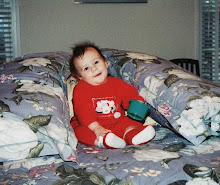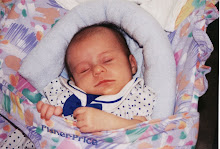What’s Wrong With My Baby?
By Kelly Bruce
8-March-2008
I knew my baby was a girl from the very first pregnancy test. I was thrilled, a little baby girl of our very own. When people would ask the usual, “What are you hoping for?” I’d reply the standard, “We’d love a girl…but we’d love a little boy too…as long as our baby is healthy and strong, that’s all that really matters”.
Jasmine Ruby was born nine days early after a very long, difficult and complicated labour. She was born drug-free, alert and breastfed extremely well from minute one. I felt proud, relieved and exhausted with this beautiful little red-headed girl. She was perfect.
During the first week at home, however I started to feel a little niggle that something wasn’t quite right. Jasmine’s head would mainly face to the right, with her chin slightly pointing upwards and all the way around to her right shoulder. She slept only facing the right. The first really scary incident happened in that first week where she seemed unable to move her head towards the left to breastfeed, crying and screaming. I called, hysterical, to my mother in another room, “Mum, something’s wrong with her, I think I’ve broken her neck, help, help!” Mum rushed in and was the voice of calm and reason and everything seemed fine after a minute or two. We put it down to a strong will (like her Mum) and got on with our day.
Even though I was a nervous first-time Mum, dealing with a lot of post-labour complications and trips back to the hospital for myself my instincts kept telling me that something was wrong with my baby.
I mentioned my concerns to the clinic midwives who came out to do a home visit. They gave me advice on how to position Jasmine’s basinet to encourage movement of her head to both sides and told me it was fairly common and not to worry. A flattened spot appeared behind her right ear from lying on it so much. The few times she fell asleep facing to the left side she would wake crying because she was unable to turn her head from the left up to the midline, I would have to gently help her turn her head. Doctors, midwives and the hospital all told me she was fine, not to worry, it was common, she’d grow out of it. I wasn’t convinced and I had this constant sense of anxiety about what was wrong with my beautiful little baby?
Jasmine was a very vomity baby who was obviously distressed and uncomfortable in the capsule and in her little chair. She seemed to have trouble getting comfortable unless it was on her back, facing to the right.
At fifteen weeks things were only getting worse. I took Jasmine to the local clinic’s paediatric physiotherapist who rushed us through, didn’t listen to what I was trying to explain, wasn’t concerned with Jasmine’s flattening head shape, showed me some stretches to do for Jasmine’s neck and range of movement (Jasmine cried the entire time). I walked back to the car and cried. Was I just being a neurotic first-time mother? I was beginning to doubt myself and my instincts and I didn’t know where to turn next.
I started doing the stretches for Jasmine’s neck muscles every day. She slept one night facing to the left side but cried on-and-off all night and couldn’t turn her head up to the middle when she woke in the morning. I knew there was more to this.
At sixteen weeks I was breastfeeding her lying down at bedtime when she suddenly went into what looked like a mini seizure or muscle spasm. Her head flung around to the right, her eyes pulled up to the right corner and her right arm shot up to the right side. She had three of these, each lasting about 6 seconds and cried in pain and fear.
At the follow-up appointment with the paediatric physio she didn’t seem to have any idea what I was talking about with the seizure-type events and said it was probably wind pain! Meanwhile, Jasmine’s head and face shape was becoming more and more asymmetrical from favouring her right. She always held her shoulders up quite high and she seemed more rigid than other babies down her right side when she was held.
More terrifying episodes of spasms/seizures started happening. At the shopping centre when I was carrying her facing forwards in the pouch I felt her little body go suddenly rigid and twist around to the right in an arc shape. She cried and whimpered in pain and fear. Her face looked pale and sickly, it was a completely different colour to normal. Her eyes moved up to the right corner and each spasm lasted about 6 seconds. She had 6 or 7 more of these when we got her home, triggered every time we would lie her down flat on her back. After panadol she gradually relaxed and had a good nights sleep.
I was out of my head with worry when the same thing continued in the morning. We decided to take her to Emergency where she was seen straight away. My husband had to hold down his precious four and a half month old baby girl while the nurses tried to take blood. She was screaming and looking at him with pleading eyes while I cried nearby and he cried as he held her arms down. It was just one of the many traumatic experiences we were to go through on our journey to find out what was wrong with our baby.
The spasms didn’t happen at the hospital (of course!) and the nurses, paediatritian, midwives and doctors could not tell us what was happening. She was admitted overnight for tests. She had blood tests, an ultrasound of her fontanelles in her head, EEG and ECG which were all normal.
I decided to stop doing the stretches as I worried it was triggering these spasm/seizure episodes and I knew her problem was more complex than just a tight neck. I started taking her to an osteopath who was very relaxing for Jasmine and helped her to have wonderful sleeps afterwards. I also started gently stretching Jasmine’s neck in my bed every morning for 2-3 hours while she was asleep, just holding her little head over to the left and gently holding her right shoulder down.
When she reached 6 months her range of movement was gradually improving. I’d also started doing lots of tummy time with her. She started to roll and started sleeping on her tummy which seemed much more comfortable for her. At this time a very noticeable left head tilt started appearing. It would come on suddenly and stay for days. In her rocker chair, in the car, on the floor and in her cot her head would tilt to the left. When she was in her highchair her head would be almost on the left side arm rest on the worst days. She would be even more vomity than usual when she had the tilt.
My husband and I would desperately try to work out what was triggering all this. Was it something we were doing? What were the common factors each time the tilt came back or the spasm/seizure episodes happened? Our list of possible triggers included: too much time under fluorescent lights at the shopping center, being carried upright in her pouch, having vaccinations, being overtired and being put down flat onto her back from an upright position.
None of this made sense to anyone else. I knew I had to start researching for myself. I spent many, many hours over the next few weeks on the internet searching for answers and information. I felt sure we were dealing with either ‘Congenital Muscular Torticollis’ (a reasonably well-known condition involving damaged neck muscles) or perhaps even a rarer form of torticollis called ‘Benign Paroxysmal Torticollis’ which presented as seizure-like episodes, vomiting, headache and periodic head tilting of both sides.
At the next horrible incident of seizure/spasms and crying we knew we had to video it happening if we were ever going to get to the bottom of this. It started once again at the shops when she was being held upright in her pouch. We rushed home and grabbed the camera, my husband filming as I cried and panicked and tried to help my baby.
Jasmine’s paediatritian said it looked like seizures and had nothing to do with her neck. She didn’t want to listen to me when I said I felt sure that it wasn’t actually seizures. She had no time for my questions. I never went back to her.
Our doctor was wonderful and said she really was unsure and that my research seemed to be taking us in the right direction. She got us an emergency appointment with a paediatric nuerologist at Westmead Children’s Hospital. We went to this appointment a few weeks later armed with a complete written history of our baby so that no detail would be skipped over and some of the research we had found. I was really feeling sure that Jasmine must have ‘Benign Paroxysmal Torticollis’. It was the only thing that truly fit.
Jasmine’s paediatric neurologist was wonderful, experienced, thorough and agreed that we had arrived at the right diagnosis. She said she had only dealt with 5 other cases in her career. She didn’t have any new information for us other than what we’d already found on the internet. We had to rule out a few last things before we could be sure that this was the correct diagnosis.
Jasmine had neck x-rays to rule out bone deformities which were normal. I also took her to a highly recommended peadiatric physiotherapist which was pointless. She had an expensive visit to an eye specialist to rule out Occular Torticollis which showed all normal results. We took her across the city to the plagiocephaly (misshapen head) clinic at Randwick Children’s Hospital and the wonderful doctor there was kind and supportive and felt that Jasmine’s head and face was going back to normal now that she was up off her right side more and more. She definitely didn’t need a helmet to reshape her head. We agreed and felt somewhat relieved but also knew that it had taken an enormous amount of effort and heartache on our part to improve her range of movement with very little support from the medical profession in the early months.
The last big test was an MRI to rule out tumors on her spinal cord. This was a horrible and emotional experience for my husband and I and a scary experience for Jasmine, who had to have a general anaesthetic. I will never forget the feeling of holding my baby while the mask to sedate her was placed over her little face. She struggled like she was fighting for her life and then she went limp in my arms as she became sedated. I was shaken and emotional for ages.
All results eventually came back normal. Our paediatric neurologist made the official diagnosis of ‘Benign Paroxysmal Torticollis’ when Jasmine was seven months of age. I sent copies of information about this rare condition to all the health professionals who hadn’t been sure or hadn’t taken us seriously in the hope that they will be better informed if they ever come across this condition again.
‘Benign Paroxysmal Torticollis’ is a rare medical condition that is nuerological.. Most of the medical world have never heard of it and there have been very few studies done world-wide. In fact, it seems impossible to find any long-term research to show what happens to these babies into childhood and adulthood. The medical studies we have found say that it is a non-life threatening condition involving vomiting, headaches, dizziness, alternating head tilts and episodes that look like seizures but are more like muscle spasms and that most children seem to grow out of it by school age.
It is linked to childhood vertigo disorders and migraine disorders. It is passed on genetically, linked to hemiplegic (one-sided) migraine which runs through my family from my maternal Grandfather, my maternal aunties, my sister and myself. A recent study has made some connection with a gene mutation linked to calcium channels in the body. It has also been linked to possible inner ear problems. ‘Benign Paroxysmal Torticollis’ is often misdiagnosed as epilepsy, with babies and toddlers placed on unnecessary medication.
At our follow-up visits with Jasmine’s paediatric neurologist she has suggested trying mega doses of vitamin B2. This has been impossible to give due to the bitter taste no matter how we had the chemist mix it up for her. Our neuro also said we could try her on anti-migraine drugs which we decided against at this young age. She said we could have some expensive genetic testing done but it would only prove that the migraine gene has been passed from me to Jasmine, and we already know that!
Jasmine is now nineteen months old. Last night my husband and I spent an hour sitting on her bedroom floor holding her while she had spasms and then vomited and vomited until there was nothing left. She has started telling me when she feels ‘sickie’, when she needs her vomit bowl and when she needs to lie down in her cot. She gets dizzy some days and rubs her eyes and gets a bit ‘spaced-out’ on her bad days before the spasms start. If we are really vigilant and get panadol into her system at these early signs, we think it might stop the symptoms progressing.
I have kept a calendar of her symptoms from about 4 months of age. She had many months of a pretty regular pattern of left head tilt for 7 days, 2 days of her worst symptoms (spasms, vomiting, light sensitivity, noise sensitivity, rubbing eyes, face a sickly colour, generally unhappy), 7 days of being perfectly normal, then slight right head tilt and the bad symptoms for 2 days then back to the left tilt again!
In the last few months she has had more and more normal days. The spasms and vomiting days are further apart (we even went eight weeks over Christmas between episodes). The head tilt is becoming less severe when it does appear. We are really hoping that it is starting to go.
We are much more prepared and watchful now, for instance we know that a slight right tilt is the sign that spasms and vomiting are on the way. We know that if she has even one spasm, then we have a few minutes to grab bowls, a cool washer and towels before the vomiting starts. We also know that she will always seem to ‘pass out’ into a deep sleep after these episodes. She usually wakes up normal, as though her brain has somehow ‘reset’ itself.
She is also clumsy on her tilt days and needs to be supervised so that she doesn’t hurt herself. We feel that her triggers are: not getting enough sleep, getting too much sun or glare in her eyes, getting sick and even perhaps too much physical/upside-down/rough activity.
Jasmine is a gorgeous, happy, intelligent 19 month old. She reached all her milestones early, is very verbal and active and is otherwise completely normal. She crawled and walked well and her head and face shape are almost perfect. I’m sure some people feel that we are a bit overprotective of Jasmine now and we try desperately not to be (she does Gymbaroo and swimming and playing at the park like the other bubs we know). The hard thing for us is that nobody else in our circle of friends and family has actually seen a full episode happening.
Thankfully both my Mum and my husband’s Mum have seen the vomiting part which gave them some degree of understanding. But it usually happens at night or at home because we see the warning signs and stay home. I do, however, have awful memories of holding a crying spasmsing baby in a shopping queue trying frantically to find something for her to vomit into. We’ve also had to race home from days out and cancel many plans when her episodes have started. I’m sure people have been offended, not realizing what our reality has been for the last nineteen months.
It has only been this week that I have finally found and made contact with another parent who has a child with the same diagnosis. This child is ten and is in the USA and still having all of the same symptoms. I have also found out through this parent’s blog site that there are 2 more babies in Australia with ‘Benign Paroxysmal Torticollis’….maybe more that are yet to be diagnosed.
I have written this to shed some light on this rare medical condition, to share the emotional and frightening journey that we have had, to make contact with any other parents going through the same thing and to provide some information for any other parents who are currently crying their eyes out and tearing their hair out with worry about what is wrong with their baby. Our beautiful babies are going to be fine and even if true migraine does set in during the years ahead there are many options available for their treatment. We learned many months ago that the calmer we stay, the less frightened Jasmine becomes. We still have many questions and will continue to search for more information and for other families dealing with ‘Benign Paroxysmal Torticollis’.
KB
Saturday, March 8, 2008
Subscribe to:
Posts (Atom)


